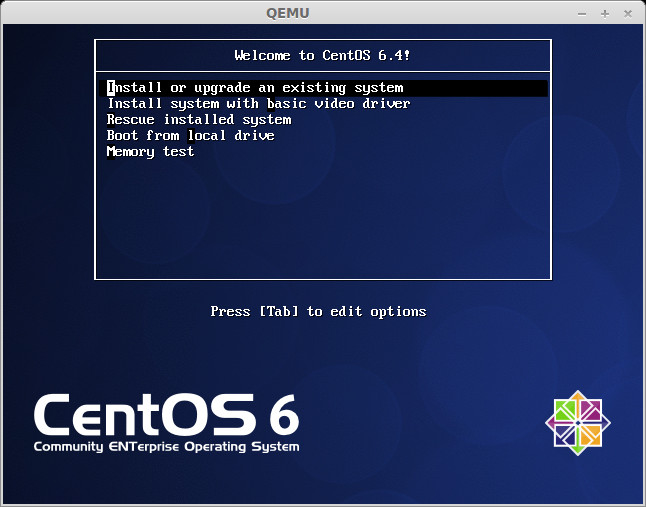Simplifying the Workflow
Recently I’ve applied some DevOps ideas to my software development workflow. With the help of virtualization and Ansible, I was able to create a basic CentOS6 and Python2.7 configuration management template.
Goals
-
Avoid OS noise; stick to CentOS6
-
Have the freedom to micromanage software versions as needed, though hopefully others will do most of the work for me
-
Utilize configuration management and server orchestration for smooth deployments
-
Work with disposable VM snapshots
-
Avoid adding too much complexity in the name of simplification
The rest of this document is a high level walk-through of how I’ve achieved some of these goals so far.
VM setup
Kids, don’t try this at home.
Create a new VM disk image.
$ qemu-img create -f qcow2 centos64base.img 10G
Formatting 'centos64base.img', fmt=qcow2 size=10737418240 encryption=off
cluster_size=65536 lazy_refcounts=offCreate a basic KVM start script.
#!/bin/bash
LOGFILE="$HOME/logs/centos64base.log"
DRIVE="-drive file=/mnt/120G-MLC/images/centos64base.img,cache=none,aio=native"
CDROM="-boot d -cdrom /mnt/1tera/images/CentOS-6.4-x86_64-minimal.iso"
NET="-net user,hostfwd=tcp:127.0.0.1:5022-:22 -net nic,macaddr=12:34:83:a5:13:16"
SMP=4
MEM=4096
# maintenance
nohup kvm -smp $SMP -m $MEM -vga std $DRIVE $CDROM $NET > $LOGFILE 2>&1 &
# daemon
#nohup kvm -smp $SMP -m $MEM -nographic -serial none $DRIVE $NET > $LOGFILE 2>&1 &Install CentOS6.4

Setup networking
The VM should have access to the internet, and be accessible via SSH over the host-guest port forward.
Setup pubkey authentication as root
$ scp -P 5022 ~/.ssh/id_rsa.pub root@localhost:~/
root@localhost's password:
$ ssh -p 5022 root@localhost
root@localhost's password:
Last login: Wed May 15 21:26:24 2013 from 10.0.2.2
# mkdir .ssh
# cat id_rsa.pub >> .ssh/authorized_keys
# chmod 700 .ssh
# chmod 600 .ssh/authorized_keys
# exit
$ ssh -p 5022 root@localhost
Last login: Wed May 15 21:31:28 2013 from 10.0.2.2Shutdown the VM.
Take a snapshot
At this point we have a bare bones functional CentOS6.4 VM, so take a qcow2 snapshot.
$ qemu-img snapshot -c base centos64base.img
$ qemu-img info centos64base.img
image: /home/peter/120g/images/centos64base.img
file format: qcow2
virtual size: 10G (10737418240 bytes)
disk size: 936M
cluster_size: 65536
Snapshot list:
ID TAG VM SIZE DATE VM CLOCK
1 base 0 2013-05-15 16:21:13 00:00:00.000From here, we can iterate using qcow2 snapshots.
CentOS6 and Repositories
CentOS6 was chosen because it is a stable target that receives security
updates. It also has a decent packaging system based on rpm which makes
for relatively easy management.
Out of the box, the available packages for CentOS6.4 are a little spotty, so additional repositories are needed to fill the gaps.
-
The EPEL repository provides a massive (8,700+) set of packages.
-
The PUIAS Computational repository provides a
python27package and some common libraries which can be installed independently of the system’spythonecosystem.
Rather than log in to the VM and manually add these repositories, it is a good time to bring configuration management in to the mix to avoid this kind of tedium.
Ansible
The current mainstream tools in the “configuration management” space (primarily Puppet and Chef) didn’t impress me. Neither did the lower level libraries such as Fabric. I wanted something simple, hackable, at the right level of abstraction, and with batteries included. Salt seemed like a solid contender at first, but ultimately the need for master/slave daemons felt icky. I plan to take a second look at these tools, but for now, I’ve been having fun with Ansible.
Ansible is a new tool for managing systems based on sshd and Python 2.4+.
The README
explains it better than I could.
Bootstrapping a Development VM
So far we have created a “base” CentOS6.4 VM snapshot and discussed the use of
rpm and Ansible. Now let’s apply our tools to create a Python2.7
development environment. This section describes my first baby steps with
Ansible; the latest “playbooks” are tracked at github:psftw/simple-ansible.
Create a hosts file to define the connection to our VM
[vm-dev]
localhost ansible_ssh_port=5022Verify we can reach the vm-dev system with Ansible
$ ansible vm-dev -m ping -u root
localhost | success >> {
"changed": false,
"ping": "pong"
}Create a “common” role, which installs EPEL, vim, and dstat.
roles/common/tasks/main.yml
---
- name: Add EPEL repository
copy: src=epel.repo dest=/etc/yum.repos.d/epel.repo
- name: Add EPEL GPG KEY
copy: src=RPM-GPG-KEY-EPEL-6 dest=/etc/pki/rpm-gpg
- name: Install basic tools
yum: name={{ item }} state=latest
with_items:
- vim
- dstatInclude relevant static files
$ ll roles/common/files/
total 24K
-rw-r--r-- 1 peter peter 957 May 15 22:50 epel.repo
-rw-r--r-- 1 peter peter 1.7K May 15 22:34 RPM-GPG-KEY-EPEL-6Create a “python” role, which installs PUIAS, python27 and some additional
libraries.
roles/python/tasks/main.yml
---
- name: Add PUIAS repository
copy: src=puias.repo dest=/etc/yum.repos.d/puias.repo
- name: Add PUIAS GPG KEY
copy: src=RPM-GPG-KEY-puias dest=/etc/pki/rpm-gpg
- name: Install python27 and friends
yum: name={{ item }} state=latest
with_items:
- python27
- python27-devel
- python27-imaging
- python27-matplotlib
- python27-nose
- python27-pygments
- python27-tools
- graphviz-python27Create a top-level playbook to apply these roles to our VM
vm-dev.yml
---
# bootstrap a dev vm
- hosts: vm-dev
gather_facts: no
user: root
roles:
- role: common
- role: pythonExecute the playbook (after turning off the Cowsay “feature”)
$ ansible-playbook vm-dev.yml
PLAY [vm-dev] *****************************************************************
TASK: [Add EPEL repository] ***************************************************
ok: [localhost]
TASK: [Add EPEL GPG KEY] ******************************************************
ok: [localhost]
TASK: [Install basic tools] ***************************************************
ok: [localhost] => (item=vim,dstat)
TASK: [Add PUIAS repository] **************************************************
ok: [localhost]
TASK: [Add PUIAS GPG KEY] *****************************************************
ok: [localhost]
TASK: [Install python27 and friends] ******************************************
ok: [localhost] =>
(item=python27,python27-devel,python27-imaging,python27-matplotlib,python27-nose,python27-pygments,python27-tools,graphviz-python27)
PLAY RECAP ********************************************************************
localhost : ok=6 changed=0 unreachable=0 failed=0Since I had already applied this configuration to the system, Ansible didn’t need to make any changes.
Verify python2.7 in our VM:
Python 2.7.3 (default, Mar 11 2013, 22:38:13)
[GCC 4.4.7 20120313 (Red Hat 4.4.7-3)] on linux2
Type "help", "copyright", "credits" or "license" for more information.
>>> import PIL, matplotlib, nose, pygments, gv
>>>Redistributing rpm
- Obtain some
rpmfiles. Optionally —resign them. - Run
createrepoto generate repository metadata - Configure yum to use the repository
This is useful when you want to distribute original rpm packages, or you
need to push to servers that don’t have internet access.